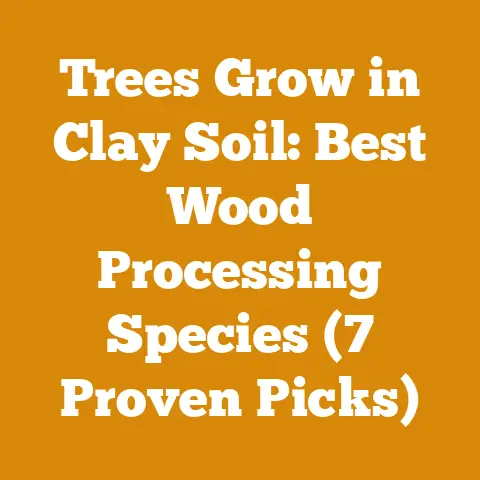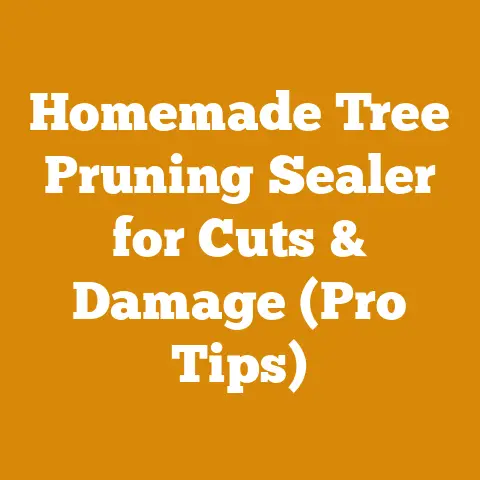Timber Rights Explained (Maximize Your Wood Harvest Potential)
I understand the frustration of watching valuable timber stand idle on your property, knowing its potential but feeling unsure how to unlock it legally and sustainably. I’ve been there myself, staring at acres of opportunity, but hesitant to act without a solid grasp of timber rights. This article is designed to provide you with that solid grasp. We’ll explore the ins and outs of timber rights, equipping you with the knowledge to maximize your wood harvest potential while respecting legal boundaries and ensuring responsible forest management. Let’s dive in and turn those standing trees into a valuable resource.
What are Timber Rights?
Timber rights are a bundle of legal entitlements associated with owning or managing trees on a piece of land. They define who has the authority to harvest, sell, and profit from the timber. These rights can be owned separately from the land itself, creating complex ownership scenarios.
Think of it like mineral rights. You might own the surface of the land, but someone else could own the rights to any oil or gas beneath it. Similarly, timber rights can be severed from the surface ownership. This separation often occurs through historical transactions or specific clauses in property deeds.
Key Components of Timber Rights:
- Right to Harvest: This is the core right, granting permission to cut down and remove trees.
- Right to Sell: The right to sell the harvested timber and retain the proceeds.
- Right to Manage: This may include the right to plant, thin, and otherwise manage the forest to improve timber production.
- Access Rights: The right to access the land for harvesting and management activities.
Why are Timber Rights Important?
- Legal Compliance: Harvesting timber without proper rights can lead to severe legal penalties, including fines and even criminal charges.
- Financial Security: Understanding your timber rights allows you to maximize the financial return from your timber resources.
- Sustainable Forestry: Knowing your rights enables you to manage your forest sustainably, ensuring long-term productivity and environmental health.
- Property Value: Clearly defined timber rights can enhance the value of your property.
Understanding the Different Types of Timber Rights
Navigating the world of timber rights requires understanding the different ways these rights can be held and transferred. Here are the most common types:
- Fee Simple Ownership: This is the most straightforward scenario. If you own the land in fee simple, you generally own the timber rights as well, unless explicitly stated otherwise in the deed.
- Severed Timber Rights: As mentioned earlier, timber rights can be separated from the land ownership. This means someone else owns the right to harvest the timber on your property. These rights are often held for a specific period or until a certain volume of timber is harvested.
- Timber Leases: A timber lease grants someone the right to harvest timber for a specified period, in exchange for rent or royalties. This is a common arrangement for large timber companies.
- Easements: An easement grants someone the right to use your land for a specific purpose. A timber easement might allow a logger to access your property to harvest timber on a neighboring property.
- Government Regulations: Federal, state, and local regulations can significantly impact your timber rights. These regulations may restrict harvesting practices, protect endangered species, or require permits for certain activities.
Real-World Example:
I once encountered a situation where a landowner was surprised to learn that the timber rights on his property were owned by a timber company dating back to a transaction in the 1950s. He had assumed that owning the land meant owning everything on it. This highlights the importance of thoroughly researching property records before making any assumptions about timber rights.
How to Determine Who Owns the Timber Rights on Your Property
Determining the ownership of timber rights is a crucial first step. Here’s a step-by-step approach:
- Review Your Deed: Carefully examine your property deed for any clauses that mention timber rights. Look for any reservations, exceptions, or transfers of timber rights to other parties.
- Title Search: Conduct a title search at your local county courthouse or registry of deeds. This will reveal any recorded documents that affect the ownership of timber rights.
- Consult with a Real Estate Attorney: A real estate attorney specializing in timber law can provide expert guidance on interpreting legal documents and determining the ownership of timber rights.
- Contact a Forester: A consulting forester can assess the timber on your property and provide information on local timber markets and regulations. They can also help you understand the implications of different timber rights scenarios.
Data Point:
According to the National Association of State Foresters, approximately 20% of privately owned forestland in the United States has severed timber rights. This underscores the importance of conducting thorough research to determine timber ownership.
The Importance of a Timber Cruise
Before making any decisions about harvesting timber, it’s essential to conduct a timber cruise. A timber cruise is an inventory of the trees on your property, providing information on species, size, quality, and volume.
Why is a Timber Cruise Necessary?
- Accurate Valuation: A timber cruise provides the data needed to accurately estimate the value of your timber.
- Harvest Planning: It helps you plan your harvest sustainably, ensuring that you don’t overcut your forest.
- Negotiating with Buyers: It gives you leverage when negotiating with timber buyers.
- Legal Compliance: It may be required by state or local regulations.
How to Conduct a Timber Cruise:
- Hire a Professional Forester: This is the best option for accurate and reliable results. A professional forester has the training and experience to conduct a thorough timber cruise.
- Do It Yourself: If you have some forestry knowledge, you can conduct a basic timber cruise yourself. There are numerous resources available online and in print to guide you. However, be aware that your results may not be as accurate as those obtained by a professional.
My Experience:
I once attempted to estimate the value of timber on a small woodlot without conducting a proper timber cruise. I significantly underestimated the volume and quality of the timber, resulting in a lower price when I sold it. This taught me the importance of accurate data when managing timber resources.
Once you’ve determined the ownership of timber rights and conducted a timber cruise, you’re ready to negotiate a timber contract. A timber contract is a legally binding agreement that outlines the terms and conditions of the timber harvest.
Key Elements of a Timber Contract:
- Parties Involved: Clearly identify the buyer and seller of the timber.
- Property Description: Provide a detailed description of the property where the timber will be harvested.
- Timber Description: Specify the species, size, and volume of timber to be harvested.
- Harvesting Practices: Outline the harvesting methods to be used, including any restrictions on cutting certain trees or areas.
- Payment Terms: Specify the price to be paid for the timber, the payment schedule, and the method of payment.
- Term of the Contract: Define the duration of the contract, including the start and end dates of the harvest.
- Access Rights: Grant the buyer the right to access the property for harvesting activities.
- Liability and Insurance: Address liability for any damage caused during the harvest and require the buyer to carry adequate insurance.
- Dispute Resolution: Outline the process for resolving any disputes that may arise.
- Environmental Protection: Include provisions to protect the environment, such as erosion control measures and restrictions on harvesting near streams or wetlands.
Protecting Your Interests:
- Get it in Writing: Always have a written timber contract. Oral agreements are difficult to enforce.
- Consult with an Attorney: Have an attorney review the contract before you sign it.
- Seek Professional Advice: Consult with a forester or other timber professional to ensure that the contract is fair and protects your interests.
- Monitor the Harvest: Regularly monitor the harvesting activities to ensure that the terms of the contract are being followed.
Warning:
I’ve seen landowners get taken advantage of by unscrupulous timber buyers who offer low prices or use destructive harvesting practices. A well-written timber contract and careful monitoring of the harvest can help prevent these problems.
Sustainable Forestry Practices
Managing your timber resources sustainably is essential for long-term productivity and environmental health. Sustainable forestry practices aim to balance timber harvesting with the conservation of forest ecosystems.
Key Sustainable Forestry Practices:
- Selective Harvesting: This involves harvesting only certain trees, leaving others to grow and regenerate the forest.
- Reforestation: Planting new trees after harvesting ensures the long-term sustainability of the forest.
- Erosion Control: Implementing measures to prevent soil erosion during and after harvesting protects water quality and soil productivity.
- Wildlife Habitat Management: Managing the forest to provide habitat for wildlife enhances biodiversity.
- Protection of Water Resources: Protecting streams, wetlands, and other water resources is crucial for maintaining water quality and aquatic ecosystems.
- Invasive Species Control: Controlling invasive plants and animals helps maintain the health and productivity of the forest.
- Forest Health Monitoring: Regularly monitoring the forest for signs of disease, insect infestations, and other threats allows for early detection and treatment.
Benefits of Sustainable Forestry:
- Long-Term Timber Production: Sustainable forestry ensures that the forest will continue to produce timber for generations to come.
- Environmental Protection: It protects water quality, soil productivity, and wildlife habitat.
- Carbon Sequestration: Forests play a crucial role in absorbing carbon dioxide from the atmosphere, helping to mitigate climate change.
- Recreational Opportunities: Healthy forests provide opportunities for hiking, hunting, fishing, and other recreational activities.
Data Point:
According to the U.S. Forest Service, sustainably managed forests can sequester up to 1.5 tons of carbon dioxide per acre per year.
Legal Considerations and Regulations
Timber harvesting is subject to a variety of federal, state, and local regulations. These regulations are designed to protect the environment, ensure worker safety, and prevent illegal logging.
Federal Regulations:
- Endangered Species Act: Protects endangered and threatened species and their habitats.
- Clean Water Act: Regulates water pollution and protects wetlands.
- Migratory Bird Treaty Act: Protects migratory birds.
State Regulations:
- Forest Practice Acts: Regulate timber harvesting practices to protect the environment.
- Water Quality Regulations: Protect water quality during and after harvesting.
- Worker Safety Regulations: Ensure the safety of loggers and other forestry workers.
Local Regulations:
- Zoning Ordinances: May restrict timber harvesting in certain areas.
- Permitting Requirements: May require permits for timber harvesting activities.
Staying Compliant:
- Know the Laws: Familiarize yourself with the federal, state, and local regulations that apply to timber harvesting in your area.
- Obtain Permits: Obtain all necessary permits before starting any harvesting activities.
- Follow Best Management Practices: Implement best management practices (BMPs) to protect the environment.
- Consult with Experts: Consult with a forester or other timber professional to ensure that you are in compliance with all applicable regulations.
Personal Story:
I once witnessed a logger who failed to obtain the necessary permits before starting a timber harvest. He was fined heavily and ordered to stop all harvesting activities until he obtained the permits. This underscores the importance of complying with all applicable regulations.
Maximizing Your Wood Harvest Potential
Now that you understand the legal and regulatory framework surrounding timber rights, let’s explore strategies for maximizing your wood harvest potential.
- Develop a Forest Management Plan: A forest management plan is a written document that outlines your goals for your forest and the steps you will take to achieve those goals. A well-developed plan can help you maximize timber production, improve forest health, and protect the environment.
- Improve Timber Quality: Implement silvicultural practices such as thinning and pruning to improve the quality of your timber. Thinning removes competing trees, allowing the remaining trees to grow faster and larger. Pruning removes lower branches, improving the quality of the wood.
- Control Invasive Species: Invasive plants and animals can negatively impact timber production and forest health. Implement measures to control invasive species and prevent their spread.
- Improve Soil Health: Healthy soils are essential for tree growth. Implement practices such as adding organic matter and controlling erosion to improve soil health.
- Diversify Your Income Streams: Consider diversifying your income streams by selling firewood, maple syrup, or other forest products.
- Seek Professional Advice: Consult with a forester or other timber professional to get expert advice on how to maximize your wood harvest potential.
Case Study:
A landowner in Maine implemented a forest management plan that included thinning, pruning, and invasive species control. Over a 10-year period, he increased the value of his timber by 50% and improved the overall health of his forest.
Firewood as a Timber Resource
While large-scale timber harvesting often dominates the conversation around timber rights, it’s important not to overlook the value of firewood. Firewood can be a significant source of income for landowners, especially those with smaller woodlots.
Legal Considerations for Firewood Harvesting:
- Timber Rights Still Apply: Even if you’re just cutting firewood, you need to ensure you have the right to do so. If timber rights are severed, you may need permission from the timber rights owner.
- Quantity Restrictions: Some regulations may limit the amount of firewood you can harvest for personal use or sale.
- Species Restrictions: Certain species may be protected, and you may not be allowed to cut them for firewood.
- Permitting: Depending on your location, you may need a permit to harvest firewood, especially on public lands.
Maximizing Firewood Value:
- Seasoning: Properly seasoning firewood is crucial for maximizing its heat output and reducing smoke. Seasoning involves drying the wood for at least six months, ideally a year.
- Species Selection: Different wood species have different heat values. Hardwoods like oak, maple, and beech provide more heat than softwoods like pine and fir.
- Efficient Splitting: Using a hydraulic splitter can significantly increase your firewood splitting efficiency.
- Marketing: Market your firewood effectively by advertising its quality, species, and dryness.
My Firewood Story:
I once spent a winter burning unseasoned firewood, and it was a miserable experience. The wood was difficult to light, produced a lot of smoke, and didn’t provide much heat. I learned the hard way the importance of properly seasoning firewood.
The Role of Technology in Timber Management
Technology is playing an increasingly important role in timber management, helping landowners make more informed decisions and improve efficiency.
Examples of Technology in Timber Management:
- GPS and GIS: Global Positioning System (GPS) and Geographic Information System (GIS) technology can be used to map forest stands, track harvesting activities, and monitor forest health.
- Remote Sensing: Remote sensing technology, such as satellite imagery and LiDAR, can be used to assess forest cover, identify areas of deforestation, and estimate timber volume.
- Software Applications: There are numerous software applications available to help landowners manage their forests, track expenses, and analyze timber markets.
- Drones: Drones can be used to conduct aerial surveys of forests, inspect timber harvests, and monitor forest health.
Benefits of Using Technology:
- Improved Accuracy: Technology can provide more accurate data on forest resources.
- Increased Efficiency: It can automate many tasks, saving time and money.
- Better Decision-Making: It can help landowners make more informed decisions about forest management.
- Enhanced Monitoring: It can improve the monitoring of forest health and harvesting activities.
Looking Ahead:
As technology continues to evolve, it will play an even greater role in timber management, helping landowners manage their forests more sustainably and efficiently.
Common Mistakes to Avoid
Even with a solid understanding of timber rights, it’s easy to make mistakes that can cost you time, money, or legal trouble. Here are some common pitfalls to avoid:
- Assuming Ownership: Don’t assume you own the timber rights just because you own the land. Always verify ownership through a title search.
- Ignoring Regulations: Failing to comply with federal, state, and local regulations can result in fines and other penalties.
- Poor Contract Negotiation: A poorly written timber contract can leave you vulnerable to exploitation.
- Neglecting Sustainable Practices: Unsustainable harvesting practices can damage your forest and reduce its long-term productivity.
- Failing to Monitor the Harvest: Not monitoring the harvest can lead to violations of the timber contract and environmental damage.
Lessons Learned:
I’ve learned from my own mistakes and the mistakes of others that careful planning, attention to detail, and a commitment to sustainable practices are essential for successful timber management.
Conclusion: Taking Control of Your Timber Rights
Understanding and managing your timber rights is essential for maximizing your wood harvest potential while ensuring responsible forest management. By following the steps outlined in this guide, you can protect your interests, comply with regulations, and sustainably manage your timber resources for generations to come.
Key Takeaways:
- Timber rights are a bundle of legal entitlements associated with owning or managing trees.
- It’s crucial to determine who owns the timber rights on your property.
- A timber cruise is essential for accurately valuing your timber.
- A well-written timber contract is vital for protecting your interests.
- Sustainable forestry practices are essential for long-term productivity and environmental health.
- Technology can play an increasingly important role in timber management.
- Avoid common mistakes by carefully planning and monitoring your timber harvests.
Next Steps:
- Research Your Timber Rights: Start by reviewing your property deed and conducting a title search.
- Consult with Professionals: Seek advice from a real estate attorney, forester, or other timber professional.
- Develop a Forest Management Plan: Create a plan that outlines your goals for your forest and the steps you will take to achieve those goals.
- Implement Sustainable Practices: Commit to sustainable forestry practices that protect the environment and ensure long-term productivity.
By taking these steps, you can take control of your timber rights and maximize your wood harvest potential while ensuring the health and sustainability of your forest.






